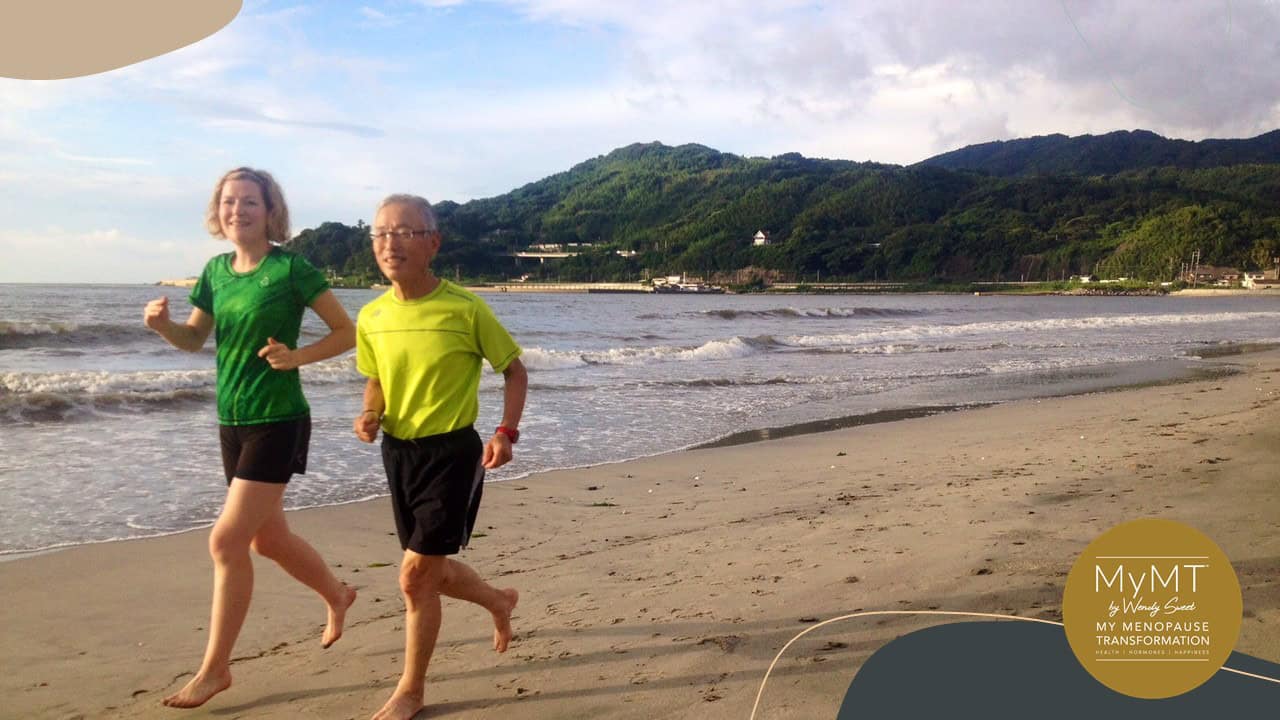We all know that a little exercise or activity makes a big difference to how we feel but in a world where there is so much choice around the type of exercise that is promoted to mid-life women, I believe that simple aerobic exercise is being forgotten. I know myself that fitness messages have become pretty confusing. That’s why I was so stoked when I got this message from Lisa, after the completion of her half-marathon last weekend here in New Zealand. A few months ago, her joints and muscles were sore from not sleeping and completing an endurance half-marathon was the last thing on her mind.
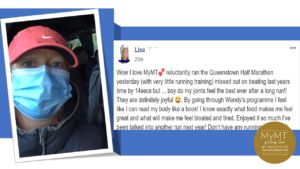
That’s why I’m having a shout-out for good old-fashioned aerobic or endurance exercise for all of us during menopause … especially those of you who want to halt your belly-fat and look after your heart health as you get older. When women come into my Re-Build My Fitness programme and/or the MyMT Transform Me programme, I love it when they understand that to lose weight, we need to be sleeping all night, turning around our liver health and backing-off too much high intensity exercise – until we restore our energy levels and of course, our joint health and function. [How to achieve this is in my ‘Restore your Joyful Joints’ module as well]. If their joints aren’t sore, I get them to walk or try some slow jogging at first.
SLOW JOGGING is an exercise method researched and promoted byProfessor Hiroaki Tanaka(Fukuoka University, Japan). That’s him in the banner to this article. He chose the term “slow jogging” to emphasise that jogging doesn’t always have to be done at pace. “Slow is a perfectly good way to do it”, says Professor Tanaka and I agree. The key he says, is to maintain niko niko pace. It is an efficient, healthier, and pain-free approach to running for all ages and lifestyles.
In Japanese, niko niko means “smile”. Unlike traditional training, that requires concentration and effort, slow jogging is more like taking a walk, at the intensity light enough to enjoy conversation or, if by yourself, to just smile.
Professor Hiroaki Tanaka formalised his system after using it to improve from 4:11 for the marathon in his thirties to 2:40 when he was fifty-years old and eventually 2:38:50 – his personal best after that.
Whilst there is a growing body of research to suggest that HIIT [high-intensity interval training] is beneficial to us, only 1 or 2 sessions a week is optimal. However, if you are overweight and you have sore joints from your changing oestrogen levels during menopause and you aren’t sleeping, then too much high-intensity exercise places increased stress and load on your muscles and joints. Then, if you aren’t sleeping, you aren’t recovering. You begin to feel worse, as Vanessa did too.
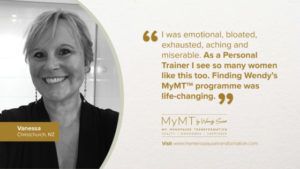
One of the main challenges we have as we age, is to maintain our flexibility of movement. With numerous physical changes occurring to our joints, tendons and ligaments as we lose the role of oestrogen, it’s important that we improve this aspect of our health. When our body loses oestrogen and progesterone, blood vessels lose their elasticity and become more constricted. This includes our coronary vessels and Professor Tanaka has been revolutionary in looking at the role of ageing on the stiffness of blood vessels which I speak about HERE.
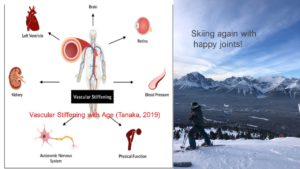
During our menopause transition, collagen levels in tendons change and in muscles we lose our Type 2 power fibres. As such, if we are regular exercisers, we can feel stiffer and tighter – especially in the morning upon waking if we haven’t slept well.
Women differ from men with regard to muscle and tendon, most likely due
to differences in sex hormones activity and tissue response, so it’s no surprise that as we age, we lose our ability to turn-over collagen as readily as we used to. When I began to experience so many injuries myself, menopause was never mentioned in all the expensive treatments I was offered. Nor was olive oil. (More on that in this post HERE).
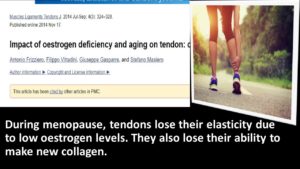
With my doctoral studies exploring women’s healthy ageing and exercise, I realised that as the first generation of women to enjoy lots of fitness activities on and off over the years, many of us have embraced the sports and fitness industries and have become used to exercising and pushing ourselves harder. But when our symptoms are over-whelming us in menopause, hard-out exercise choices may also be to the detriment of our heart health, joint function and our fat-loss as we go through menopause.
Do you remember in the 1970’s and 1980’s when women were encouraged to do more running? The increase in women’s running and walking events as well as triathlons was the ‘new-way’ to get fit, feel energised and improve health.
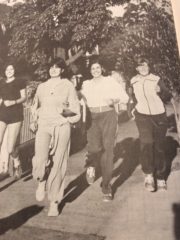 I still remember running around Dunedin in the South Island of New Zealand in my 20’s – not fast, but just steady. My two jogging friends talked the whole time and it was such a great way to stay connected. Sports science was only just getting started as one of numerous new types of physical sciences that people could study, so the research into the benefits that this low-to-moderate activity had on our cardiac health and weight management, had not been reported. Although I might add that New Zealand’s pioneer of running coaching, Arthur Lydiard OBE, and his aerobic endurance training system, was still not widely accepted back then either. But in those days, we didn’t jog slowly for the scientific benefits – we just did it because it helped us to feel good and to cope with what life was throwing at us. I had no idea back then that I was exercising aerobically and how good this was for my heart health, fat-burning and stress levels. We didn’t have the fancy running shoes or gear back then either!
I still remember running around Dunedin in the South Island of New Zealand in my 20’s – not fast, but just steady. My two jogging friends talked the whole time and it was such a great way to stay connected. Sports science was only just getting started as one of numerous new types of physical sciences that people could study, so the research into the benefits that this low-to-moderate activity had on our cardiac health and weight management, had not been reported. Although I might add that New Zealand’s pioneer of running coaching, Arthur Lydiard OBE, and his aerobic endurance training system, was still not widely accepted back then either. But in those days, we didn’t jog slowly for the scientific benefits – we just did it because it helped us to feel good and to cope with what life was throwing at us. I had no idea back then that I was exercising aerobically and how good this was for my heart health, fat-burning and stress levels. We didn’t have the fancy running shoes or gear back then either!
But here’s the thing – Aerobic exercise is more important for our fat-burning and cardiac health as we get older than we are led to believe by the fitness industry which primarily focuses on younger people and athletes.
With the emphasis on higher intensity exercise and strength training that prevails throughout the fitness industry, you would think that this is the only way to exercise, but it isn’t. Although strength training to improve bone density has an important role to play in our healthy ageing, so too does aerobic exercise. This is the type of exercise whereby we go slower for longer and in menopause and post-menopause, it’s great for our heart health. Now, thanks to Professor Tanaka, I have a new name for it – niko, niko exercise – smiling pace exercise.
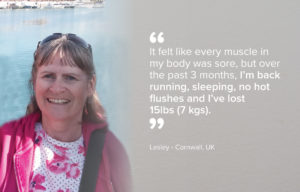
When I began to explore why the type of exercise I was doing was no longer working for my weight management when I was transitioning menopause, I realised that over the years, being in and around the fitness industry with it’s emphasis on ‘faster, leaner, stronger’, I had actually lost touch with the physiology of fat loss through exercise.
For years, the notion that ‘faster and harder is better’ was based on the fact that people didn’t have much time, so we needed shorter, harder workouts.
But here’s the thing. When you are always doing high-intensity exercise and your cardiovascular system (heart and blood vessels) are changing during menopause because you are losing oestrogen, then this higher intensity exercise makes you feel more exhausted – your body is under more stress. This crashes your progesterone levels and can also lead to sore joints and unstable blood sugar levels. Post-exercise food cravings are well known in the fitness industry, especially, sugary, high-calorie foods!
You can end up in a cycle of fatigue, endless cravings, hot flushes and weight gain … so you do more high intensity exercise, to burn off the calories, and the cycle starts all over again. Sound familiar?
The word ‘aerobic’ literally means ‘with oxygen’. And oxygen transport to our heart, muscles and every cell and tissue in the body is crucial to our optimal function, especially as we transition menopause and go into the next stage of life. That’s why I love the concept of Japan’s slow jogging movement and it’s what I promote to women on the MyMT programmes as well. This includes my fabulous new Re-Build My Fitness 12 week online programme. It helped Kaye get up to the top of Mt Taranaki in New Zealand!
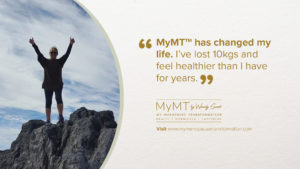
Every day I hear from women in the MyMT™ community, who say that they feel that their energy has reached an all-time low, especially when they don’t sleep well during their menopause transition. Too much exercise uses up this energy further, which is why we need to find the right exercise as we transition menopause. If we don’t, this can be a slippery slope towards worsening immune health, including fibro-myalgia.
As I have been reflecting on what is the best exercise for us as we get older and the best exercise to help us to lose our belly-fat, I have come full circle from the days of always doing high-intensity exercise. Women’s healthy ageing research supports this too. Women on the Blue Zones healthy ageing research don’t do exhausting exercise. They stay strong and fit by working in the fields and walking in the hills.
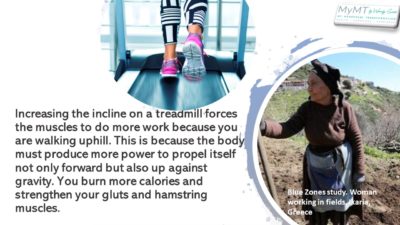 So how can we emulate this research in our everyday lives? Well we can walk some hills, do some slow jogging or we can go to the gym and walk or jog slowly on the treadmill. Building up to a minimum of 20 minutes to an hour is ideal. This is what is recommended for weight loss management in menopause when it comes to exercise and heart health (strength is also important as is flexibility, and I cover all of this and programmes that you can download in my Re-Build My Fitness programme.
So how can we emulate this research in our everyday lives? Well we can walk some hills, do some slow jogging or we can go to the gym and walk or jog slowly on the treadmill. Building up to a minimum of 20 minutes to an hour is ideal. This is what is recommended for weight loss management in menopause when it comes to exercise and heart health (strength is also important as is flexibility, and I cover all of this and programmes that you can download in my Re-Build My Fitness programme.
[Please note, that if you aren’t sleeping, or have sore joints and muscles or need to change your menopause symptoms, then I recommend you doing my symptom reduction or weight loss programmes prior to building up your exercise – or do them both at the same time.]
For women going through menopause, there’s another reason to increase our endurance or aerobic exercise too and that’s to prevent post-menopause heart disease and worsening belly-fat that can lead to Type 2 diabetes and other health problems that prevent women leading and living a life that is full of vitality as they age.
The greatest risk to women living in western countries such as New Zealand, the United Kingdom and Australia (where most of you are), is heart disease. As our blood vessels and heart muscle get older and lose oestrogen, the need to maintain optimal heart health and healthy cholesterol levels is stronger than ever. But there’s more to this story as well. Not only is heart disease a killer disease for women as they age, but so too is obesity and Type 2 diabetes. This is why exercising for cardiovascular health during menopause is so important for us as we get older. When you increase your aerobic exercise, your body releases feel-good hormones, such as endorphins, which can put you in a good mood for the rest of the day. That’s why I want women enjoying the right type of exercise in mid-life and beyond. If you want to get exercise back into your life, I hope you can join me sometime too.
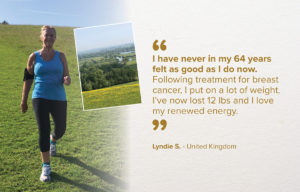
Dr Wendy Sweet, PhD/Member: Australasian Society of Lifestyle Medicine/ REPs New Zealand Registered Exercise Specialist & Your MyMT Coach.
Learn more about the Re-Build My Fitness programme by listening to my 3 minute video.
